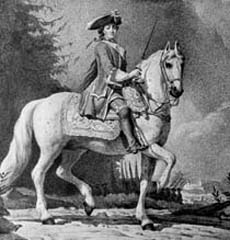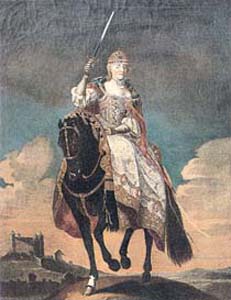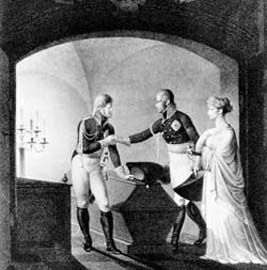Warrior Queens: Boadicea's Chariot (75 page)
Read Warrior Queens: Boadicea's Chariot Online
Authors: Antonia Fraser
Tags: #History, #General, #Social History, #World

Panel from St Faith’s Church, King’s Lynn showing Queen Elizabeth reviewing her troops at Tilbury in 1588.

A group of illustrations of the life of Jinga Mbandi, the seventeenth-century Queen of Angola, from
Relation Historique de I’Ethiopie Occidentale
by Father J. P. Labat, 1732.
Queen Jinga being received by the Portuguese Governor, Correira de Sousa, in about 1622; according to the best-known legend about her, she commanded one of her servants to form a seat when the Governor failed to offer her a chair.

Queen Jinga receives Christian baptism as the Lady Anna de Sousa (in honour of the Governor); she subsequently returned to her tribal name, variously given as Zhinga, Nzinga and Jinga.

Queen Jinga venerates the bones of her brother, whom she succeeded as ruler. (Some stories hold that she had him murdered.)

Statue of Queen Anne by Rysbrack at Blenheim Palace; the reality of her appearance was very different from this august image.

The Empress Catherine II of Russia, after a portrait by V. Erichsen painted in 1762, the year of her coronation; this followed the coup by which, at the head of the rebel regiments, she supplanted her husband Tsar Peter III. She borrowed a uniform to do so: ‘for a man’s work, you needed a man’s outfit’, she wrote.

The Empress Maria Theresa of Austria at her coronation as Queen of Hungary at Pressburg in 1742; she mounted a charger and drew her sword to the four points of the compass to signify her role as Hungary’s protector, according to the ancient tradition of the Hungarian kings.

Nineteenth-century monument to Maria Theresa opposite the Hofburg in Vienna, showing her towering majestically above her male ministers and generals.

Queen Louise of Prussia, painted by Grassi in 1802 when she was twenty-six. ‘There prevails a feeling of chivalrous devotion towards her’, wrote an English diplomat at her court; ‘a glance of her bright laughing eyes is a mark of favour eagerly sought for’.

The celebrated print of King Frederick William
III
of Prussia and the Tsar Alexander I swearing brotherhood over the tomb of Frederick the Great, watched by Queen Louise; after Napoleon’s occupation of Berlin a cruel caricature of the same print was issued, with the Tsar as Nelson and Louise as Lady Hamilton, currently notorious in Europe as Nelson’s mistress.

Napoleon receiving Queen Louise at Tilsit, 6 July 1807; the Queen is supported by her husband and watched by the Tsar. A detail from a picture by N. L. F. Gosse.

The sisters Trung Trac and Trung Nhi, Vietnamese heroines who led the first rising in their country against the Chinese in
AD
39; from a popular Vietnamese print. The characters on the flag give the family name ‘Trung’ and above the sisters (right) their own names; at lower left is Su Ding, the Chinese governor, and top left the legend ‘Queen Trung drives out the Han’.
